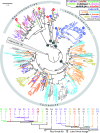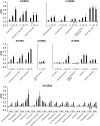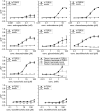At the Root of T2R Gene Evolution: Recognition Profiles of Coelacanth and Zebrafish Bitter Receptors
- PMID: 33355666
- PMCID: PMC7851594
- DOI: 10.1093/gbe/evaa264
At the Root of T2R Gene Evolution: Recognition Profiles of Coelacanth and Zebrafish Bitter Receptors
Abstract
The careful evaluation of food is important for survival throughout the animal kingdom, and specialized chemoreceptors have evolved to recognize nutrients, minerals, acids, and many toxins. Vertebrate bitter taste, mediated by the taste receptor type 2 (T2R) family, warns against potentially toxic compounds. During evolution T2R receptors appear first in bony fish, but the functional properties of bony fish T2R receptors are mostly unknown. We performed a phylogenetic analysis showing the "living fossil" coelacanth (Latimeria chalumnae) and zebrafish (Danio rerio) to possess T2R repertoires typical for early-diverged species in the lobe-finned and the ray-finned clade, respectively. Receptors from these two species were selected for heterologous expression assays using a diverse panel of bitter substances. Remarkably, the ligand profile of the most basal coelacanth receptor, T2R01, is identical to that of its ortholog in zebrafish, consistent with functional conservation across >400 Myr of separate evolution. The second coelacanth receptor deorphaned, T2R02, is activated by steroid hormones and bile acids, evolutionary old molecules that are potentially endogenously synthesized agonists for extraoral T2Rs. For zebrafish, we report the presence of both specialized and promiscuous T2R receptors. Moreover, we identified an antagonist for one of the zebrafish receptors suggesting that bitter antagonism contributed to shape this receptor family throughout evolution.
Keywords: bitter taste receptor; bony fish; calcium mobilization assay.
© The Author(s) 2020. Published by Oxford University Press on behalf of the Society for Molecular Biology and Evolution.
Figures





Similar articles
-
A singular shark bitter taste receptor provides insights into the evolution of bitter taste perception.Proc Natl Acad Sci U S A. 2023 Nov 28;120(48):e2310347120. doi: 10.1073/pnas.2310347120. Epub 2023 Nov 13. Proc Natl Acad Sci U S A. 2023. PMID: 37956436 Free PMC article.
-
Positive Darwinian selection in the singularly large taste receptor gene family of an 'ancient' fish, Latimeria chalumnae.BMC Genomics. 2014 Aug 5;15(1):650. doi: 10.1186/1471-2164-15-650. BMC Genomics. 2014. PMID: 25091523 Free PMC article.
-
Taste and odorant receptors of the coelacanth--a gene repertoire in transition.J Exp Zool B Mol Dev Evol. 2014 Sep;322(6):403-14. doi: 10.1002/jez.b.22531. Epub 2013 Sep 18. J Exp Zool B Mol Dev Evol. 2014. PMID: 24106203
-
A deadly taste: linking bitter taste receptors and apoptosis.Apoptosis. 2025 Apr;30(3-4):674-692. doi: 10.1007/s10495-025-02091-3. Epub 2025 Feb 20. Apoptosis. 2025. PMID: 39979526 Free PMC article. Review.
-
The Remarkable Diversity of Vertebrate Bitter Taste Receptors: Recent Advances in Genomic and Functional Studies.Int J Mol Sci. 2024 Nov 25;25(23):12654. doi: 10.3390/ijms252312654. Int J Mol Sci. 2024. PMID: 39684366 Free PMC article. Review.
Cited by
-
Comparative genomic analysis of immune-related genes and chemosensory receptors provides insights into the evolution and adaptation of four major domesticated Asian carps.BMC Genomics. 2025 May 26;26(1):529. doi: 10.1186/s12864-025-11719-2. BMC Genomics. 2025. PMID: 40419972 Free PMC article.
-
Expression profiles and functional characterization of common carp (Cyprinus carpio) T2Rs.Biochem Biophys Rep. 2021 Sep 2;28:101123. doi: 10.1016/j.bbrep.2021.101123. eCollection 2021 Dec. Biochem Biophys Rep. 2021. PMID: 34504956 Free PMC article.
-
Physiological activation of human and mouse bitter taste receptors by bile acids.Commun Biol. 2023 Jun 7;6(1):612. doi: 10.1038/s42003-023-04971-3. Commun Biol. 2023. PMID: 37286811 Free PMC article.
-
A singular shark bitter taste receptor provides insights into the evolution of bitter taste perception.Proc Natl Acad Sci U S A. 2023 Nov 28;120(48):e2310347120. doi: 10.1073/pnas.2310347120. Epub 2023 Nov 13. Proc Natl Acad Sci U S A. 2023. PMID: 37956436 Free PMC article.
-
Evolution of bitter receptor genes and ontogenetic dietary shift in a frog.Proc Natl Acad Sci U S A. 2023 Feb 21;120(8):e2218183120. doi: 10.1073/pnas.2218183120. Epub 2023 Feb 13. Proc Natl Acad Sci U S A. 2023. PMID: 36780530 Free PMC article.
References
-
- Adler E, et al.2000. A novel family of mammalian taste receptors. Cell 100(6):693–702. - PubMed
-
- Ammon C, Schafer J, Kreuzer OJ, Meyerhof W.. 2002. Presence of a plasma membrane targeting sequence in the amino-terminal region of the rat somatostatin receptor 3. Arch Physiol Biochem. 110(1–2):137–145. - PubMed
-
- Ballesteros J, Weinstein H.. 1995. Integrated methods for the construction of three-dimensional models of structure-function relations in G protein-coupled receptors. Methods Neurosci. 25:366–428.
-
- Behrens M, Blank K, Meyerhof W.. 2017. Blends of non-caloric sweeteners saccharin and cyclamate show reduced off-taste due to TAS2R bitter receptor inhibition. Cell Chem Biol. 24(10):1199–1204 e1192. - PubMed
MeSH terms
Substances
LinkOut - more resources
Full Text Sources
Molecular Biology Databases

